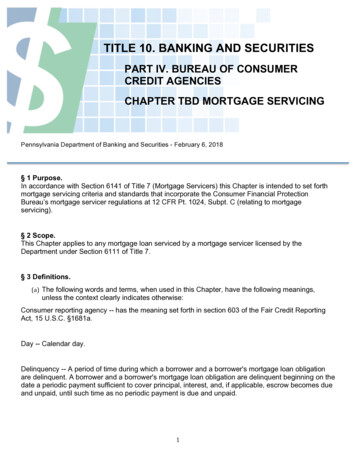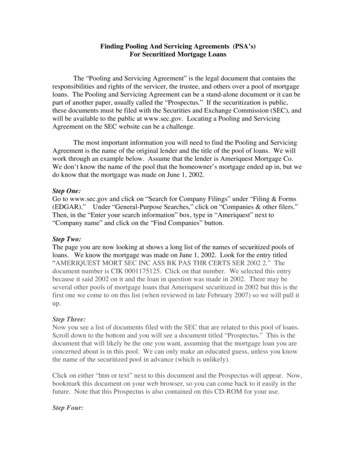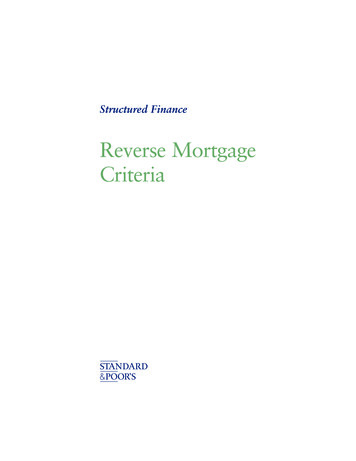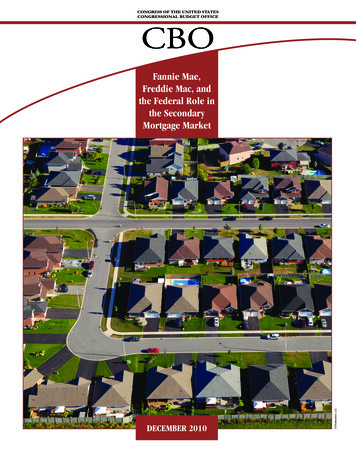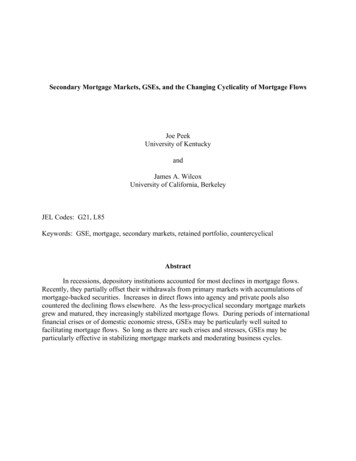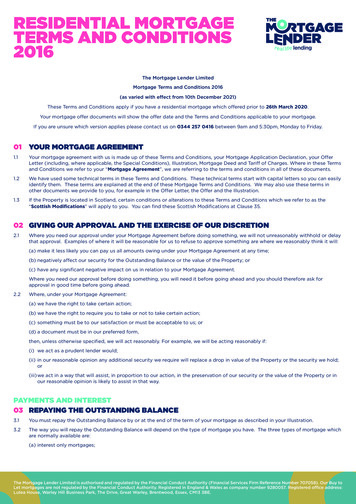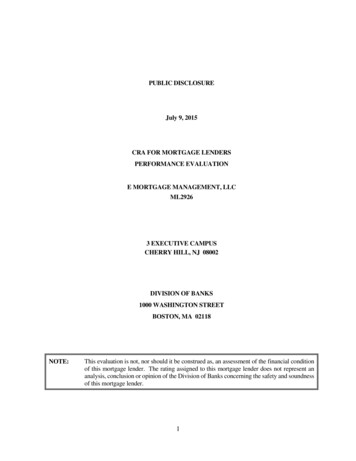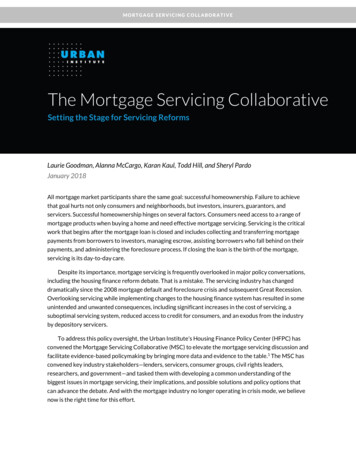
Transcription
MORTGAGE SERVICING COLLABORATIVEThe Mortgage Servicing CollaborativeSetting the Stage for Servicing ReformsLaurie Goodman, Alanna McCargo, Karan Kaul, Todd Hill, and Sheryl PardoJanuary 2018All mortgage market participants share the same goal: successful homeownership. Failure to achievethat goal hurts not only consumers and neighborhoods, but investors, insurers, guarantors, andservicers. Successful homeownership hinges on several factors. Consumers need access to a range ofmortgage products when buying a home and need effective mortgage servicing. Servicing is the criticalwork that begins after the mortgage loan is closed and includes collecting and transferring mortgagepayments from borrowers to investors, managing escrow, assisting borrowers who fall behind on theirpayments, and administering the foreclosure process. If closing the loan is the birth of the mortgage,servicing is its day-to-day care.Despite its importance, mortgage servicing is frequently overlooked in major policy conversations,including the housing finance reform debate. That is a mistake. The servicing industry has changeddramatically since the 2008 mortgage default and foreclosure crisis and subsequent Great Recession.Overlooking servicing while implementing changes to the housing finance system has resulted in someunintended and unwanted consequences, including significant increases in the cost of servicing, asuboptimal servicing system, reduced access to credit for consumers, and an exodus from the industryby depository servicers.To address this policy oversight, the Urban Institute’s Housing Finance Policy Center (HFPC) hasconvened the Mortgage Servicing Collaborative (MSC) to elevate the mortgage servicing discussion andfacilitate evidence-based policymaking by bringing more data and evidence to the table.1 The MSC hasconvened key industry stakeholders—lenders, servicers, consumer groups, civil rights leaders,researchers, and government—and tasked them with developing a common understanding of thebiggest issues in mortgage servicing, their implications, and possible solutions and policy options thatcan advance the debate. And with the mortgage industry no longer operating in crisis mode, we believenow is the right time for this effort.
About the Mortgage Servicing CollaborativeThe Housing Finance Policy Center’s Mortgage Servicing Collaborative is a research initiative that seeks to identify and buildmomentum for servicing reforms that make the housing market more equitable and efficient.One core MSC objective is to improve awareness of the role and importance of mortgage servicing in the housing financesystem. Since 2013, HFPC researchers have studied the landscape, followed the work and policies put in place after thecrisis, and assessed the impact of the servicing industry on consumers and communities. This includes loss mitigation andforeclosure actions and how servicing practices affect access to credit through tight underwriting standards. The UrbanInstitute has analyzed and convened forums on emerging issues in mortgage servicing, including calls for reforms, the impactof mortgage regulation, the rise of nonbank servicers, and the implications for consumers and communities. We determinedthat a focused effort that involves external stakeholders and resources could lead the way in developing policy andstructural recommendations and bring visibility to the important issues that lie ahead.The MSC has convened key industry stakeholders—including lenders, servicers, consumer groups, civil rightsorganizations, academics, and regulators—to develop an evidence-based understanding of important factors and to developand analyze solutions and implications with a well-rounded and actionable orientation.The MSC seeks to bring new evidence, data, and recommendations to the forefront; foster debate and analysis on issues from regulatory reform, technology innovations, cost containment, and consumeraccess to mortgages; and produce and disseminate our research findings and policy recommendations—including perspectives by MSC members—to offer policy options that can clarify and advance the debate and ensure servicing is addressed in broader housingfinance reform.For more information about the MSC or to see other publications, news, and products, visit the MSC program collaborative.Mortgage Servicing Collaborative Participants AmeriFirst: Mark Jones and Greg WarnerBank of America: Terry Laughlin and Larry WashingtonBayview: Rich O’Brien and Julio AldecoceaBlack Knight Financial Services: Joseph NackashiCaliber Home Loans: Tricia Black, Marion McDougall, and Lori FosterColonial Savings: David Motley and Jane LarkinGenworth: Steve Hall and Carol BouchnerGuild Mortgage Company: David BattanyHousing Policy Council and Hope Now: Paul Leonard, Meg Burns, and Eric SelkJPMorgan Chase: David Beck, Ramon Gomez, Erik Schmitt, and Diane KortKatie Porter: Faculty at University of California, IrvineMortgage Bankers Association: Justin Wiseman, Mike Fratantoni, and Sara SinghasMr. Cooper: Jay Bray and Dana DillardNational Community Stabilization Trust: Julia GordonNational Fair Housing Alliance: Lisa RiceNorthern Ohio Investment Corp.: Mark VinciguerraOcwen: John Britti and Jill ShowellPatricia McCoy: Faculty at Boston CollegePennyMac: David Spector and Karen ChangPricewaterhouseCoopers: Sherlonda Goode-Jones, Peter Pollini, and Genger CharlesQuicken Loans: Mike Malloy, Pete Carroll, and Alex McGillisSelf Help Credit Union/Center for Responsible Lending: Martin Eakes and Mike CalhounTed Tozer: Milken Institute, Former President of Ginnie MaeUnion Home Mortgage: Bill CosgroveU.S. Bank: Bryan BoltonWells Fargo: Brad Blackwell, Raghu Kakumanu, and Laura Arce
In this brief, the first in a series prepared by HFPC researchers with the collaboration of the MSC,we review how we arrived at the present state of affairs in mortgage servicing and explain why it isimportant to institute mortgage servicing reforms now.The Current Mortgage Servicing LandscapeTo understand the current servicing environment, we must understand how it functioned before theforeclosure crisis (Kaul and Goodman 2016). Before 2007, servicing consisted primarily of processinghomeowners’ mortgage payments with a set of monthly tasks: generating monthly statements,collecting payments from borrowers, and keeping track of fees and escrow items. Most homeownersmade their payments in full and on time. For the small share of borrowers that went delinquent,servicers were required to engage in “loss mitigation” to minimize losses for the entity backing the loan,such as the Federal Housing Administration (FHA), US Department of Veterans Affairs (VA), FannieMae, Freddie Mac, or a private investor. This was achieved either by getting the borrower to resumemonthly payments or by a foreclosure sale, whose proceeds would pay off the loan. Low default ratesalso meant that servicers deployed a limited operational infrastructure for loss mitigation. Servicingthus received little attention from policymakers and the public and was primarily viewed as astraightforward function in the complicated housing finance system.The foreclosure crisis in 2007 upended the precrisis servicing model. Servicers were stillresponsible for collecting and processing borrower payments and for minimizing losses for investors.But the number of borrowers who needed mortgage payment assistance skyrocketed in a short periodand raised awareness of mortgage servicing to a level where it became a focus for policymakers. Risingdelinquencies brought two new issues to the forefront: (1) the difficulty of ramping up servicingoperations to meet significantly increased volume and (2) lack of adequate loss mitigation options.SETTING THE STAGE FOR SERVICING REFORMS3
FIGURE 1Loans in Serious Delinquency or ForeclosureShare of loans 90 days delinquent or in foreclosureShare of loans in foreclosureShare of loans 90 days delinquent10%9%8%7%6%5%4%3%2%1%0%3Q00 3Q01 3Q02 3Q03 3Q04 3Q05 3Q06 3Q07 3Q08 3Q09 3Q10 3Q11 3Q12 3Q13 3Q14 3Q15 3Q16Sources: Mortgage Bankers Association and the Urban Institute.Note: 3Q00 third quarter of 2000.In recognition of the need to improve loss mitigation and help borrowers stay in their homes,several federal entities—including Fannie Mae, Freddie Mac, the FHA, the Consumer FinancialProtection Bureau, the federal prudential banking regulators, and the US Department of the Treasury—devised new loss mitigation programs (e.g., the Home Affordable Modification Program). New servicingrules and guidelines were also put in place, significantly affecting servicing operations. Although theserequirements existed before the 2008 crisis, they were less comprehensive. In the precrisis model,investors granted servicers flexibility to account for the unique needs of an individual borrower, and insome cases, there were limited options for loss mitigation, especially for payment-reducingmodifications. Borrowers moved from default to foreclosure status if they could not pay theirmortgages in a timely manner. The new rules established requirements for every step of the process,including how and when to contact a borrower and what loss mitigation options to offer and in whatorder.Although the new rules increased standardization, many rules were not aligned among investors,creating different servicing protocols depending on who owned, insured, or guaranteed the mortgage.The insurer or guarantor of the loan (e.g., the FHA, VA, US Department of Agriculture, Fannie Mae, orFreddie Mac) or a private investor is responsible for creating the rules that minimize losses for itsportfolio. Depending on the investor, insurer, or guarantor, there can be large variation in the assistance4SETTING THE STAGE FOR SERVICING REFORMS
a servicer can offer a distressed homeowner. Two homeowners living next door to each other and facingsimilar hardship could be offered completely different loss mitigation products from the same servicer.The Importance of Loss MitigationThe period following the housing crisis was a time of distress for borrowers and communities. Becauseof the substantial rise in the number of delinquent borrowers and nationwide house price declines,working with servicers to obtain payment assistance, generally in the form of loan modifications,became important. There was often confusion about the relief options available, leading to delayed orinadequate assistance. In addition, early versions of new loan modification programs requiredsubstantial and time-consuming adjustments to maximize effectiveness. Many mortgages failed to cure(i.e., become current again), and many properties lost value. Additionally, many borrowers had riskysubprime loan products that were governed by proprietary servicing agreements that made it difficultto modify the loans. By the time some of these issues were addressed, many more borrowers hadentered default or foreclosure, some of which could have been prevented.These experiences helped the nation’s servicing system and policymakers learn important lessons,including the importance of efficient loan modifications offering meaningful payment relief. A loanmodification is a permanent change in the original terms of the mortgage. It typically involves acombination of term extension, rate reduction, and principal forbearance. The goal is to reduce themonthly payment to a more affordable level and help cure the default. Crisis-era loan modificationswere helped by falling interest rates across the board, which made it less expensive for investors toreduce monthly payments. This raises an important implication for the future of loan modifications. Asinterest rates rise, many borrowers with postrecession, ultra-low-rate government-insured mortgageswho become delinquent may not see reduced payments under current loan modification products,which rely heavily on interest rate reduction. Members of the MSC agree this is a major issue that needsto be addressed. The second brief under the MSC umbrella will examine this issue.When loan modifications and other home retention options fail to cure a delinquency, servicers lookat foreclosure alternatives, such as short sales and deeds in lieu of foreclosure, as the next options.These tools allow borrowers to exit their homes without going through time-consuming and expensiveforeclosures. If these options fail to resolve the delinquency, the servicer must begin foreclosureproceedings. For FHA-insured mortgages, foreclosure is even more expensive and time consumingbecause servicers must repair foreclosed properties after auction and convey them to the FHA. It takesmore than a year to convey a foreclosed property to the FHA, resulting in substantial propertypreservation and other expenses, for both the FHA and the servicers. Reforming the FHA’s foreclosureand conveyance process could thus result in significant cost savings for the FHA and the MutualMortgage Insurance Fund. The third MSC brief will examine these and related issues concerning theFHA’s foreclosure and conveyance processes and offer recommendations to reduce loss severities forthe FHA, reduce unnecessary costs for servicers, and improve outcomes for borrowers andneighborhoods.SETTING THE STAGE FOR SERVICING REFORMS5
The Risks of Inefficient ServicingThe risks of an inefficient mortgage servicing system are borne by consumers, neighborhoods,government, and the industry. The costs of servicing mortgage loans have increased since the 2008foreclosure crisis.2 Between 2008 and 2016, the per loan cost of servicing a “nonperforming” loan, onethat is either delinquent or in default, has more than quadrupled, from 482 to 2,113. The cost ofservicing a “performing” loan, one for which the borrower is not behind on payments, has nearly tripled,from 59 to 163, according to the Mortgage Bankers Association’s survey of mortgage servicers.3FIGURE 2Servicing Costs per Loan, Performing and Nonperforming LoansPerformingNonperforming 2,386 2,358 2,113 2,009 1,965 1,246 911 704 482 592008 772009 902010 962011 156 11420122013 1562014 181 16320152016Source: Mortgage Bankers Association Servicing Operations Study and Forum.These increasing costs negatively affect all stakeholders in the housing finance system.ConsumersFor consumers with mortgage loans, servicers are the touch point throughout the mortgage cycle.Consumers need servicers who can assist them through a difficult and complicated delinquency. As thecosts of servicing nonperforming mortgages has increased, some lenders have reduced lending or raisedlending costs to first-time homeowners and low-to-moderate-income borrowers out of concern thatthese borrower segments present a higher likelihood of default. This is particularly the case for the FHA,6SETTING THE STAGE FOR SERVICING REFORMS
which insures loans to these groups. Improving servicing efficiency and reducing servicing costs willkeep more consumers in their homes, encourage more lenders to remain active in the FHA space, andreduce the incentive to curtail access to credit.Mortgage Servicing IndustryThe high costs of servicing have a direct impact on servicers’ bottom lines. Because of this and otherreasons, the servicing industry is dealing with an exodus of servicers, especially depository institutions.4Many large, federally regulated depository financial institutions have pulled back from the mortgagemarket in recent years. This void is being filled by “nondepository institutions,” whose market share hasgrown substantially, especially within the FHA space (State Street and HFPC 2017, 30). Absent thisgrowth, access to credit would be tighter and servicing capacity more limited. Another recentdevelopment is the rise of subservicing, an arrangement under which the entity that owns mortgageservicing rights subcontracts the servicing of the loan to another entity with more specialized skills or amore efficient servicing infrastructure. The unpaid principal balance of servicing that is subserviced hasmore than doubled from about 900 billion in 2013 to more than 2 trillion today, according to InsideMortgage Finance. Reforming and simplifying mortgage servicing could reduce the cost of servicing,improve economics of the servicing business, and motivate institutions that have shrunk their footprintto consider returning.Federal Regulators, Insurers, GuarantorsFederal agencies create and enforce mortgage servicing rules and regulations. These agencies regulatefour main risks: systemic risk, solvency risk, market conduct risk, and investor risk. The Federal ReserveBoard and the Financial Stability Oversight Council supervise mortgage servicing for systemic risk. Thefederal prudential banking regulators (including the Office of the Comptroller of the Currency, theFederal Reserve Board, and the Federal Deposit Insurance Corporation) regulate mortgage servicingfor solvency risk. The Consumer Financial Protection Bureau and the Federal Trade Commissionoversee mortgage servicing for market conduct risk to borrowers. Finally, federal mortgage guarantors(primarily Fannie Mae, Freddie Mac, and Ginnie Mae) and insurers (FHA, VA, and the US Department ofAgriculture) impose mortgage servicing rules to minimize their own credit and counterparty risk.Bringing loans that experience distress back to current status is critical for these entities because thelonger loans stay in delinquency, the greater the losses are for the entity backing the loan.Housing CounselorsMore than 2,000 US Department of Housing and Urban Development–approved housing counselorswork in the nation’s states and territories. Primarily nonprofits and housing counselors help borrowerssucceed at homeownership by counseling them on financial management and other necessary steps tocontinue paying their mortgages. Consumers trust their housing counselors and turn to them when theyexperience financial hardships. The housing counselor is the consumer’s advocate, interfacing with theSETTING THE STAGE FOR SERVICING REFORMS7
servicer to help the borrower catch up on payments. Because housing counselors advocate for the bestsolutions for borrowers, they benefit from more efficient and effective mortgage servicing.Research to Enable Sound PolicyMortgage servicing today is much more complex, tightly regulated, and sophisticated than precrisisservicing. The housing crisis taught us that the quality of mortgage servicing influences the health of thebroader housing market. And because the housing market constitutes approximately 15 percent of thenation’s economy, an effective mortgage servicing system is critical to strong regional economies and toa thriving national economy.Although experts recognize that mortgage servicing is complicated and expensive, research on thenegative impact of this complexity and cost is sparse. We need to better understand how we cansimplify and streamline servicing, reduce servicing costs, and create better outcomes for borrowers.Because mortgage servicing is often not central to discussions about major housing policy debates, it isimperative that this critical function be better understood. And because most of the postcrisisregulatory overhaul is behind us, because delinquencies are low, and with housing finance reformlegislation once again in the works in Congress, now is the right time for servicing reforms.To that end, HFPC is releasing a series of publications in 2018 based on the work of its MortgageServicing Collaborative that examine key servicing issues and provide recommendations for resolvingthem. This introductory brief sets the stage by explaining the importance of mortgage servicing to theoverall health of the housing market. Upcoming publications will analyze specific areas where reformsto current policies could improve servicing efficiency and create a win-win for government insurers,industry, and consumers. These upcoming briefs will include the following: Loan modifications for government-insured loans. This brief will examine issues concerningthe efficacy of government (FHA, VA, US Department of Agriculture) loan modifications in arising rate environment. When a delinquent borrower obtains a loan modification, themortgage rate is typically reset to the prevailing market rate, which can be higher or lower thanthe original note rate. When the market rate is lower than the original rate, providing paymentreduction becomes inherently easier and less expensive. When the market rate is higher thanthe note rate, providing payment reduction becomes more expensive, making it more difficultto cure the delinquency. In this brief, we offer recommendations to ensure continuedavailability of effective loan modifications in a rising interest rate environment. The FHA’s foreclosure and conveyance process. Relying on proprietary data shared by servicermembers of the MSC, this brief will examine the FHA’s foreclosure and conveyance processes.This brief will outline key findings from the data we collected and offer recommendations tosimplify and streamline these processes to reduce loss severities for the FHA, reduce costs forservicers, and improve outcomes for borrowers and neighborhoods.8SETTING THE STAGE FOR SERVICING REFORMS
The recommendations made in upcoming MSC publications will offer opportunities to improvemortgage servicing. These changes center on the government agencies that backstop mortgage loansand could be addressed as part of the housing finance reforms and policy enhancements discussed inthe near future. The Mortgage Servicing Collaborative and the Urban Institute’s Housing Finance PolicyCenter welcome the opportunity to engage in meaningful deliberations and discussion with allstakeholders.Notes1.For more information about the Mortgage Servicing Collaborative, see “The Mortgage ServicingCollaborative,” Urban Institute, Housing Finance Policy Center, accessed December 28, ollaborative. For a glossary of relevant terms, see “Mortgage Servicing Glossary,” Urban Institute, HousingFinance Policy Center, accessed January 5, 2018, orative/mortgage-servicing-glossary.2.Marina Walsh, “MBA Chart of the Week: Servicing Costs per Loan (Single-Family)—Performing v.Nonperforming,” MBA Newslink, July 24, 2017, orming-vnon-performing.3.These costs can vary from servicer to servicer depending on the share of delinquent loans in portfolio, theshare of these loans in judicial versus nonjudicial foreclosure states, share of conventional loans versusgovernment loans, and overall servicer efficiency.4.Karan Kaul, Bing Bai, and Laurie Goodman, “Five Things Every Policymaker Should Know about Nonbanks andthe Evolving Mortgage Industry,” Urban Wire (blog), Urban Institute, September 5, olving-mortgage-industry.ReferencesKaul, Karan, and Laurie Goodman. 2016. “Nonbank Servicer Regulation: New Capital and Liquidity RequirementsDon’t Offer Enough Loss Protection.” Washington, DC: Urban Institute.State Street and HFPC (State Street Global Advisors and the Urban Institute’s Housing Finance Policy Center).2017. Global Markets Analysis Report: A Monthly Publication of Ginnie Mae’s Office of Capital Markets. Boston:State Street; Washington, DC: Urban Institute.About the AuthorsLaurie Goodman is codirector of the Housing Finance Policy Center at the UrbanInstitute. The center provides policymakers with data-driven analyses of housingfinance policy issues they can depend on for relevance, accuracy, and independence.Before joining Urban in 2013, Goodman spent 30 years as an analyst and researchdepartment manager at several Wall Street firms. From 2008 to 2013, she was a seniormanaging director at Amherst Securities Group LP, a boutique broker-dealerspecializing in securitized products, where her strategy effort became known for itsSETTING THE STAGE FOR SERVICING REFORMS9
analysis of housing policy issues. From 1993 to 2008, Goodman was head of globalfixed income research and manager of US securitized products research at UBS andpredecessor firms, which were ranked first by Institutional Investor for 11 straight years.Before that, she was a senior fixed income analyst, a mortgage portfolio manager, and asenior economist at the Federal Reserve Bank of New York. Goodman was inductedinto the Fixed Income Analysts Hall of Fame in 2009. Goodman serves on the board ofdirectors of the real estate investment trust MFA Financial, is an adviser to AmherstCapital Management, and is a member of the Bipartisan Policy Center’s HousingCommission, the Federal Reserve Bank of New York’s Financial Advisory Roundtable,and Fannie Mae’s Affordable Housing Advisory Council. She has published more than200 journal articles and has coauthored and coedited five books. Goodman has a BA inmathematics from the University of Pennsylvania and an MA and PhD in economicsfrom Stanford University.Alanna McCargo is codirector of the Housing Finance Policy Center at the UrbanInstitute, where she focuses on center development and strategy, including thecultivation of innovative research partnerships and initiatives within Urban and withexternal stakeholders. She is also executive director of Urban’s Mortgage ServicingCollaborative. Before joining Urban, McCargo was head of CoreLogic GovernmentSolutions, working with federal and state government agencies, regulators,government-sponsored enterprises, and universities to deliver custom data, analytics,and technology solutions to support housing and policy research. Previously, she heldleadership roles with Chase and Fannie Mae, managing mortgage productdevelopment, servicing portfolios, policy efforts, and mortgage servicingtransformation and alignment efforts. From 2008 to 2011, she worked on behalf of theUS Treasury Department on implementing federal housing programs, including theMaking Home Affordable loss mitigation and foreclosure prevention initiatives withlenders, servicers, and investors nationwide. McCargo has a BA in communicationsfrom the University of Houston and an MBA from the University of Maryland.Karan Kaul researches topical housing finance issues to highlight the market impact ofongoing regulatory, industry, and related developments. He is also responsible formonitoring and reporting on mortgage market trends and current events weekly. Hebrings a deep understanding of key reform issues, political landscape surroundingreform, and pros and cons of different approaches concerning their impact onmortgage rates, credit availability, private capital, and other factors. He holds abachelor’s degree in electrical engineering and a master’s degree in businessadministration from the University of Maryland, College Park.Todd Hill is the policy and research program manager at the Urban Institute’s HousingFinance Policy Center. He manages and coordinates all aspects of the center’s highprofile programs and research. Previously, Hill served six years as senior director ofgovernment affairs at the Financial Services Roundtable’s Housing Policy Council10SETTING THE STAGE FOR SERVICING REFORMS
(HPC), where he directed the council’s government affairs efforts in advocating on themortgage and housing marketplace interests of HPC member companies in legislative,regulatory, and judicial forums. Most notably, Hill led financial service industry effortsto improve industry compliance with the Servicemembers Civil Relief Act and the newMilitary Lending Act. Hill is an honorary admiral of the Texas Navy and an honorarycolonel from the Commonwealth of Kentucky for distinguished service in governmentfor his work on service member and military veteran affairs issues. Hill previouslyworked in quality and risk management with CitiCapital, a subsidiary of Citigroup, from2000 to 2008 and was active in Texas politics as a campaign and political consultant formore than 10 years. Hill graduated from the University of Texas at Arlington, where hewas competitively selected to be a Bill Archer Fellow and received a BA in politicalscience with a minor in philosophy.Sheryl Pardo is the associate director of communications in the Housing Finance PolicyCenter at the Urban Institute, where she ensures that the center’s impartial data andexpert analyses are readily available to and understood by policymakers and thegeneral public. She helps researchers make their work accessible in blog posts andnewsletters and through social and traditional media outlets. Before joining Urban,Pardo was a strategic communications expert for several for- and nonprofitorganizations. At the Mortgage Bankers Association, she developed communicationsstrategies and compelling content for the government affairs and executive offices. Shealso designed and conducted a competitive assessment and directed an internalstrategic planning process for senior leadership and the board of directors. At the USDepartment of Housing and Urban Development, where Pardo was a senior adviser,she oversaw all speechwriting activities for housing secretary Andrew Cuomo andworked on various multifamily issues for Federal Housing Administrationcommissioner William Apgar. She is a licensed attorney and practiced environmentallaw in San Francisco for five years. Pardo holds an AB in East Asian studies fromHarvard University and a JD from Cornell University.SETTING THE STAGE FOR SERVICING REFORMS11
AcknowledgmentsThis brief was made possible by members of the Urban Institute’s Mortgage Servicing Collaborative. Weare grateful to them and to all our funders,
Quicken Loans: Mike Malloy, Pete Carroll, and Alex McGillis Self Help Credit Union/Center for Responsible Lending: Martin Eakes and Mike Calhoun Ted Tozer: Milken Institute, Former President of Ginnie Mae Union Home Mortgage: Bill Cosgrove U.S. Bank: Bryan Bolton Wells Fargo: Brad Blackwell, Raghu Kakumanu, and Laura Arce


